THROUGH THE DECADES – THE 1950s
National Broadcasting Company’s New Burbank Studios
It was the late 1940s; Radio City West in Hollywood had been converted for television, and NBC had launched its newest television station for Los Angeles (now known as Channel 4, KNBC). NBC was quickly outgrowing the iconic Hollywood broadcast center. As production increased, the need for more space became apparent. The network, and its then-parent, the Radio Corporation of America (RCA), decided to build a new television studio complex. Internally nicknamed NBC Color City, the studio would be exclusively equipped for color television broadcasting, a technology that RCA (Radio Corporation of America) was still developing.
A site in Burbank was selected. However, the United States was at war in Korea, and like during WWII, steel, aluminum, and copper wire went to defense contractors first. Before NBC bought the land in Burbank, it needed assurances from the National Production Authority that it could get the required materials to support the construction of its new studios.
In October of 1950, NBC made the first public mention of their intentions in a brief article in Broadcasting Magazine.
NBC TV Center sees January Start – “With building permit and materials clearance from National Production Authority in Washington expected by mid-January, NBC will break ground for its proposed new West Coast $25 million radio-TV center in Burbank, California, late next month, according to present plans.
“NBC has earmarked around $2 million for the first unit of the project which will front on Alameda and California Sts., it was said.”
RCA, NBC’s parent company, had purchased the property in Burbank from both the city of Burbank and Warner Bros. Studios executive Jack Warner, and turned yet again to The Austin Company to design, engineer, and construct the new 48-acre television studio complex that would become NBC’s new West Coast Headquarters. The first pencil went to paper on the design in February 1951. Construction began in March, two months later, with Studios 1 and 3 opening on October 4, 1952, for black and white television, not color.
These new studios were unlike any others designed and constructed to date. Unlike the typical motion picture theater of the time with its small stage and maximum seating capacity, NBC’s new television studios were designed with large stage areas and auditorium seating for only 500. This allowed plenty of room for scenery, acting, and an operating area for the cameras and associated equipment.
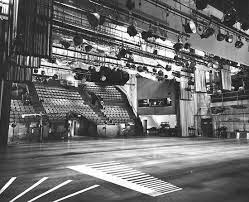
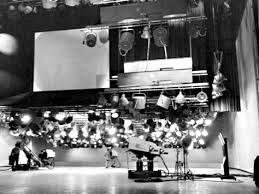
NBC Studios 1 and 3 were in heavy use from the start. But color television would have to wait for approval from the FCC until December 1953. In the east, NBC’s first color studio was The Colonial Theater which came online as an experimental facility in March 1953. NBC Brooklyn 1 was the second color studio in September 1954.
Burbank’s color studios were added one by one. Studio 2 was built first, followed by Studio 4, and were called the first television studios built just for color. These two studios, and the entire Burbank complex, were dedicated on March 27, 1955 – two and a half years after the opening of Studios 1 and 3. On May 30, 1955, Humphrey Bogart would make his first (and last live) appearance on television in Studio 2 when he, Lauren Bacall, and Henry Fonda starred in The Petrified Forest, the first “Producers Showcase” live color drama broadcast from NBC Color City West.
Studios 1 and 3 followed in transition to color with upgrades to electrical and air conditioning systems (also by Austin) to accommodate the added requirements for the color television cameras.
Austin upgraded and expanded the studio complex’s production and technical facilities as television grew and technology advanced throughout the 1960s, 70s, 80s, and 90s. The last of seven major television studios, Studio 11, was completed in 1984.
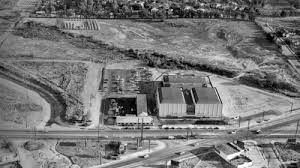
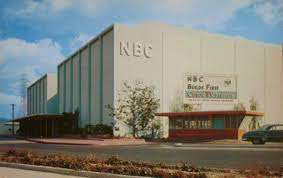
Regarding the design and construction of the first phase in 1951-52, the October 1952 issue of Radio Age published the following:
- NBC’s New TV Center on West Coast Finished in Record Time
- Roomy Studios and Service Quarters Embody the Latest Advances in Design and Construction.
- Two large studios and a vast service building operating at high speed.
- Spacious facilities for stars, including dressing rooms with showers, and a steam room.
- Ten additional dressing rooms; four for choruses.
- Large rehearsal halls
- Carpentry shop, paint shop, and large scenery storage area.
- Structural innovations [by Austin], including site-cast concrete wall panels [not standard in 1951-52 as they are today], speed up construction.
NBC Burbank hosted the production of many of the iconic variety and game shows from the 1950s through the 1990s, including The Tonight Showbeginning in 1972. In that year, Johnny Carson moved the show to California from New York, where it remained until 2014. The show would return to New York with Jimmy Fallon as host ending a 42-year era of the show’s taping from Southern California.
The Tonight Show broadcast from Studio 1, except when Bob Hope produced his specials. The show moved to Studio 3 when Jay Leno became the host and then to Studio 11 in March 2010, until the show’s move back to New York.
Hollywood Squares was produced at NBC Burbank from 1966 to 1980.
Local Los Angeles television station KNBC moved to the Burbank complex in 1962, where it operated until moving to the Universal Studios lot in 2014.
The Burbank complex (once nicknamed NBC Color Studio) was The West Coast home of NBC Television for 62 years.
Join us next month as we discuss the 1960s and Austin’s California office ventures into a series of new market segments.
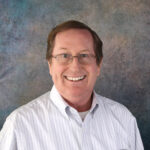 |
KEN STONEVice President and Project ExecutiveCall 949.451.9009 | Email Ken | View Profile |